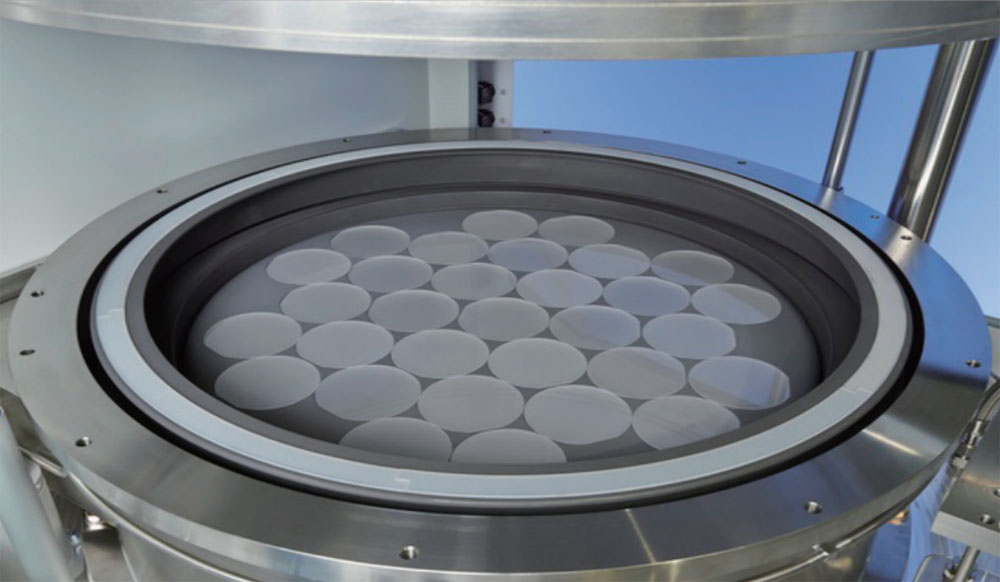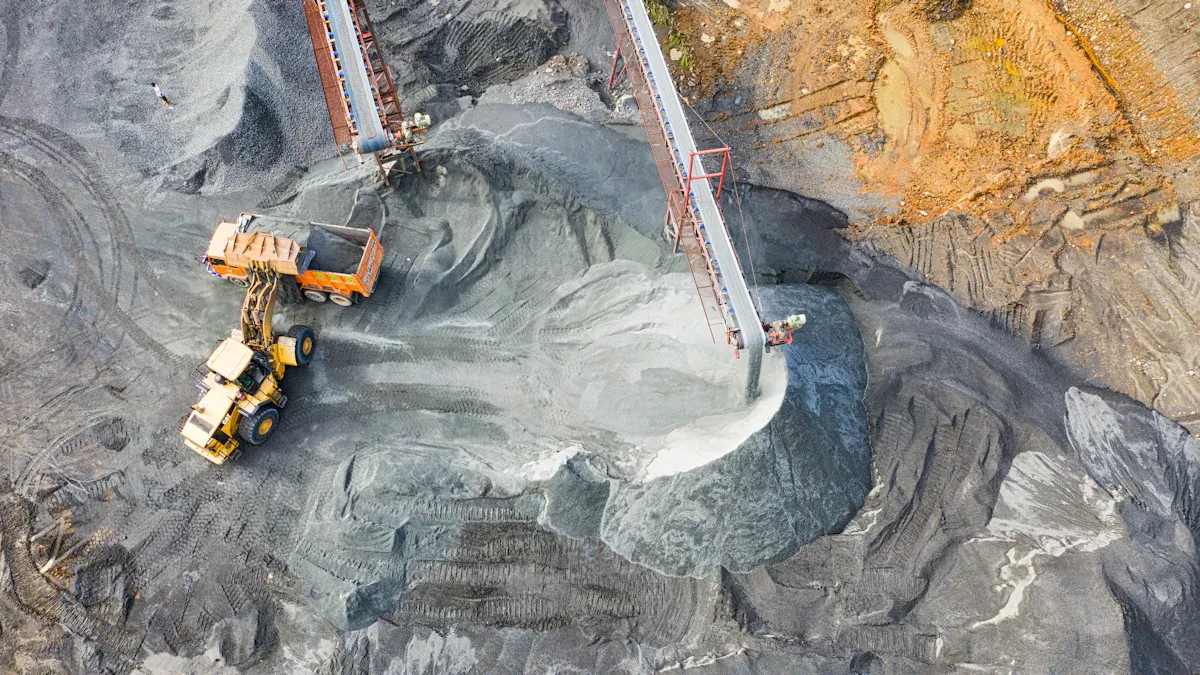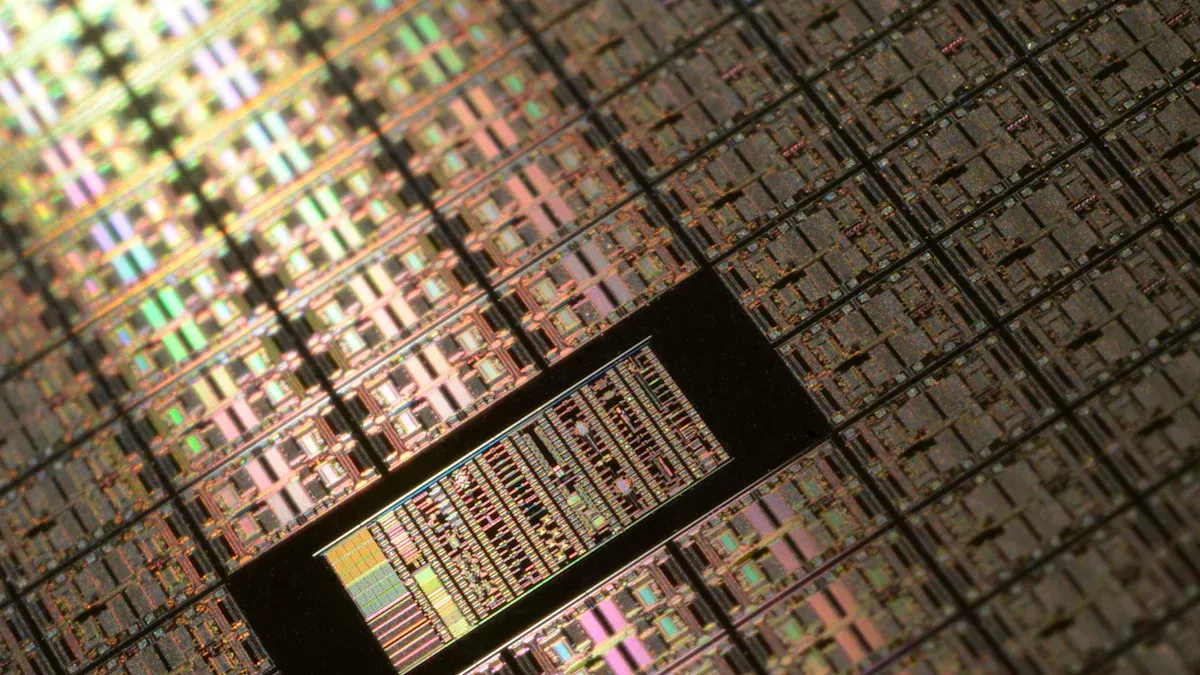
Graphite is a remarkable material, but it has its limits. You might notice it struggles with corrosion, wear, and high temperatures in demanding environments. This is where silicon carbide coating comes to the rescue. By applying a sic coating on graphite, you create a protective layer that boosts its durability and resistance. Silicon carbide coating in graphite applications ensures better performance, especially in industries requiring extreme precision and stability. This transformation makes silicon carbide coating in graphite an essential solution for modern industrial challenges.
Key Takeaways
- Silicon carbide coating keeps graphite safe from damage and heat.
- It helps graphite stay strong in very hot conditions.
- The coating makes graphite tougher, so it lasts longer and costs less to fix.
- Coated graphite works well in fields like space travel and energy.
What is Silicon Carbide Coating in Graphite?
Definition and Composition of Silicon Carbide Coating
Silicon carbide coating is a protective layer applied to graphite surfaces. It combines silicon and carbon atoms in a crystalline structure, forming a material that is both lightweight and incredibly strong. This coating bonds tightly to the graphite, creating a seamless barrier that shields it from harsh environments.
You’ll often find silicon carbide coatings created through advanced processes like chemical vapor deposition (CVD). This method ensures the coating is uniform and adheres perfectly to the graphite. The result is a material that retains the natural benefits of graphite while gaining the superior properties of silicon carbide.
Unique Properties of Silicon Carbide
Silicon carbide stands out due to its exceptional hardness, which rivals that of diamonds. This makes it highly resistant to scratches and mechanical wear. Its thermal conductivity is another remarkable feature. It efficiently transfers heat, making it ideal for high-temperature applications.
You’ll also appreciate its chemical resistance. Silicon carbide can withstand exposure to acids, alkalis, and other corrosive substances without degrading. Additionally, it maintains its strength and stability even under extreme conditions, such as rapid temperature changes or prolonged heat exposure.
These unique properties make silicon carbide coating in graphite a game-changer. It transforms graphite into a material capable of performing in environments where uncoated graphite would fail.
Why is Silicon Carbide Coating Essential for Graphite?
Challenges of Using Pure Graphite
Graphite, while versatile, has limitations that can hinder its performance in demanding environments. You might notice that pure graphite is highly susceptible to corrosion when exposed to harsh chemicals. This makes it unsuitable for applications involving acids, alkalis, or other reactive substances.
Thermal degradation is another significant challenge. Graphite can oxidize or weaken when subjected to extreme temperatures, especially in the presence of oxygen. This reduces its reliability in high-temperature industrial processes.
Mechanical wear also poses a problem. Graphite’s natural softness makes it prone to scratches, erosion, and surface damage. Over time, this wear can compromise the structural integrity of graphite components, leading to frequent replacements and higher maintenance costs.
These challenges limit the use of pure graphite in industries that demand durability, chemical resistance, and thermal stability.
How Silicon Carbide Coating Overcomes These Challenges
Silicon carbide coating acts as a shield, addressing the weaknesses of pure graphite. When applied, it forms a robust barrier that protects the graphite from corrosive substances. This allows you to use graphite in environments where it would otherwise degrade quickly.
The coating also enhances thermal stability. Silicon carbide can withstand extreme temperatures without breaking down, ensuring that the graphite remains intact even in high-heat applications. This makes it ideal for industries like semiconductor manufacturing and aerospace, where temperature control is critical.
In terms of mechanical wear, silicon carbide’s exceptional hardness provides a durable surface that resists scratches and erosion. This significantly extends the lifespan of graphite components, reducing the need for frequent replacements.
By combining the natural benefits of graphite with the superior properties of silicon carbide, this coating transforms graphite into a material capable of meeting the demands of modern industrial applications. It ensures that you can rely on graphite for both performance and longevity.
Key Benefits of Silicon Carbide Coating in Graphite

Enhanced Thermal Stability for High-Temperature Applications
When you work with materials in high-temperature environments, stability becomes critical. Graphite alone struggles to maintain its structure under extreme heat, especially when oxygen is present. Silicon carbide coating changes this. It creates a protective layer that prevents oxidation and thermal degradation.
This coating allows graphite to perform reliably in applications where temperatures soar. For example, in semiconductor manufacturing, components often face rapid and intense heat changes. Silicon carbide coating ensures that the graphite remains stable, even under these demanding conditions. You can trust it to deliver consistent performance without breaking down or losing its integrity.
Improved Resistance to Chemical Corrosion
Graphite, by itself, reacts poorly to harsh chemicals. Acids, alkalis, and other corrosive substances can weaken it over time. This limits its use in industries where exposure to such chemicals is unavoidable. Silicon carbide coating solves this problem by acting as a shield.
The coating resists chemical attacks, protecting the graphite underneath. This makes it suitable for environments where uncoated graphite would fail. For instance, in chemical processing plants, coated graphite components can handle corrosive substances without degrading. You get a material that lasts longer and performs better in challenging conditions.
Increased Mechanical Strength and Durability
Graphite’s natural softness makes it prone to wear and tear. Over time, scratches and erosion can compromise its effectiveness. Silicon carbide coating enhances the mechanical strength of graphite, giving it a harder, more durable surface.
This added durability reduces the need for frequent replacements. In industries like aerospace or energy, where reliability is crucial, silicon carbide-coated graphite components can withstand mechanical stress and maintain their performance. You benefit from a material that not only lasts longer but also reduces maintenance costs.
Extended lifespan of graphite components
When you use graphite in industrial applications, durability becomes a key concern. Over time, exposure to heat, chemicals, and mechanical stress can wear down graphite components. This leads to frequent replacements, which increase costs and disrupt operations. Silicon carbide coating in graphite solves this problem by significantly extending the lifespan of these components.
The coating acts as a protective armor. It shields graphite from the elements that cause degradation. For example, in high-temperature environments, uncoated graphite can oxidize and weaken. Silicon carbide coating prevents this by creating a barrier that resists oxidation. This ensures that the graphite remains strong and reliable, even under extreme conditions.
Chemical resistance is another factor that contributes to longevity. Without protection, graphite can corrode when exposed to acids or alkalis. Silicon carbide coating eliminates this risk. It allows graphite to perform in environments where chemical exposure is unavoidable, such as chemical processing plants or laboratories.
Mechanical wear also impacts the lifespan of graphite. Scratches and erosion can compromise its structural integrity. Silicon carbide’s hardness prevents this damage. The coating creates a durable surface that withstands mechanical stress, ensuring that graphite components last longer.
Tip: By choosing silicon carbide-coated graphite, you reduce maintenance costs and improve operational efficiency. You get a material that performs consistently over time, saving you money and effort.
Industries like aerospace, energy, and semiconductor manufacturing benefit greatly from this extended lifespan. In these fields, reliability is crucial. Silicon carbide-coated graphite ensures that components can handle demanding conditions without frequent replacements. This makes it an ideal choice for applications requiring durability and long-term performance.
Applications of Silicon Carbide-Coated Graphite

Use in Semiconductor Manufacturing
Silicon carbide-coated graphite plays a critical role in semiconductor manufacturing. You’ll find it used in wafer carriers, susceptors, and other components that must endure extreme heat during production. These parts need to maintain their shape and stability under high temperatures, and silicon carbide coating ensures they do just that.
The coating’s thermal conductivity helps regulate heat distribution, which is essential for creating high-quality semiconductors. It also resists chemical corrosion, allowing you to use it in environments where reactive gases are present. This makes silicon carbide-coated graphite a reliable choice for the precision and durability required in semiconductor fabrication.
Note: Using silicon carbide-coated graphite in semiconductor manufacturing reduces the risk of contamination, ensuring better product quality.
Role in LED Production Processes
In LED production, precision and cleanliness are non-negotiable. Silicon carbide-coated graphite components, such as heating elements and crucibles, help you achieve these standards. The coating prevents oxidation and contamination, which could otherwise compromise the quality of the LEDs.
The material’s ability to withstand rapid temperature changes is another advantage. During LED production, processes like epitaxial growth involve extreme heat fluctuations. Silicon carbide-coated graphite handles these conditions without cracking or degrading, ensuring consistent performance.
By using this material, you can improve the efficiency and reliability of LED manufacturing, leading to better products and lower production costs.
Importance in High-Temperature Heating Systems
High-temperature heating systems demand materials that can endure intense heat without breaking down. Silicon carbide-coated graphite excels in this area. Its thermal stability allows you to use it in furnaces, heat exchangers, and other equipment that operates at extreme temperatures.
The coating also protects against oxidation, which is a common issue in high-heat environments. This means you can rely on silicon carbide-coated graphite to last longer and perform better than uncoated alternatives.
Tip: If you’re looking for a material that combines durability with excellent heat resistance, silicon carbide-coated graphite is an ideal choice for your heating systems.
Applications in aerospace and energy industries
Silicon carbide-coated graphite has become a vital material in aerospace and energy industries. Its unique properties allow you to tackle challenges like extreme temperatures, mechanical stress, and chemical exposure.
Why Aerospace Relies on Silicon Carbide-Coated Graphite
In aerospace applications, materials face intense heat and pressure. Rocket engines, for example, generate temperatures that can weaken uncoated graphite. Silicon carbide coating prevents this by creating a heat-resistant barrier. This ensures that graphite components, such as nozzles and thermal shields, maintain their integrity during launches and re-entry.
You’ll also find this material in satellites. Silicon carbide-coated graphite resists the harsh conditions of space, including radiation and temperature fluctuations. It helps extend the lifespan of satellite components, reducing the need for costly replacements.
Tip: Using silicon carbide-coated graphite in aerospace applications improves reliability and safety, making it a preferred choice for engineers.
Energy Industry Applications
The energy sector demands materials that can endure high temperatures and corrosive environments. Silicon carbide-coated graphite excels in these conditions. In nuclear power plants, it serves as a protective layer for graphite moderators, shielding them from radiation and chemical reactions.
You’ll also see it in solar energy systems. Silicon carbide-coated graphite enhances the efficiency of heat exchangers and thermal storage units. Its ability to withstand prolonged heat exposure ensures consistent performance, even in demanding environments.
Key Advantages
- Durability: Resists wear and tear, reducing maintenance costs.
- Thermal Stability: Handles extreme heat without degrading.
- Chemical Resistance: Protects against corrosion in harsh environments.
By choosing silicon carbide-coated graphite, you gain a material that meets the rigorous demands of aerospace and energy industries. It ensures long-term performance and reliability, helping you achieve your goals efficiently.
How is Silicon Carbide Coating Applied to Graphite?
Overview of the Coating Process (e.g., Chemical Vapor Deposition)
Applying silicon carbide coating to graphite involves advanced techniques to ensure precision and durability. One of the most common methods is Chemical Vapor Deposition (CVD). In this process, you expose the graphite to a mixture of silicon- and carbon-containing gases at high temperatures. These gases react and form a thin, uniform layer of silicon carbide on the graphite surface.
The CVD process takes place in a controlled environment, such as a vacuum chamber or a furnace. This setup ensures that the coating adheres tightly to the graphite, creating a seamless and protective barrier. The high temperatures used during the process also help the silicon carbide bond chemically with the graphite, enhancing its strength and stability.
Other methods, like plasma spraying or physical vapor deposition, may also be used depending on the application. However, CVD remains the most popular choice due to its ability to produce coatings with exceptional uniformity and precision.
Tip: The quality of the coating depends on factors like temperature, gas composition, and deposition time. Optimizing these variables ensures the best results for your specific needs.
Effectiveness and Precision of the Application Methods
The application methods for silicon carbide coating are highly effective because they create a durable and reliable protective layer. CVD, in particular, stands out for its precision. It allows you to control the thickness of the coating down to the micron level, ensuring consistent performance across all coated components.
This precision is crucial in industries like semiconductor manufacturing, where even minor imperfections can lead to significant issues. The uniformity of the coating ensures that every part of the graphite surface is protected, leaving no weak spots for corrosion or wear to occur.
Additionally, these methods enhance the graphite’s natural properties without altering its shape or size. The coating process preserves the lightweight and conductive nature of graphite while adding the superior hardness and chemical resistance of silicon carbide.
Note: Choosing the right application method ensures that your coated graphite components meet the demands of high-performance environments, from aerospace to energy systems.
Silicon carbide coating transforms graphite into a material that excels in demanding environments. You gain enhanced thermal stability, chemical resistance, and mechanical strength, making it indispensable for industries like aerospace, energy, and semiconductor manufacturing.
Key Insight: As industrial demands grow, silicon carbide-coated graphite will drive innovation in technology and manufacturing. Its durability and reliability ensure it remains a critical material for high-performance applications.
By choosing silicon carbide-coated graphite, you invest in a solution that meets today’s challenges and prepares you for tomorrow’s advancements.
| Contact Us To Get Better Information |
| By:semicera |
| Address : No. 1958 Jiangnan Road, Ningbo High tech Zone, Zhejiang Province, 315201, China |
| E-mail : sales01@semi-cera.com |
| E-mail : sales05@semi-cera.com |
| Tel : 86-0574-8650 3783 |
| Phone : 86-13373889683 |
| Skype : xianeryeah@outlook.com |
| Whatsapp : 86-13373889683 |
| Xing:https://www.xing.com/discover/your-posts |
| Pinterest:https://www.pinterest.com/Semicera/ |
| Facebook:https://www.facebook.com/profile.php?id=61575124466678 |
| Youtube:https://www.youtube.com/@Semicera |